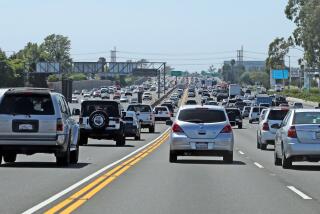CHP Rethinks Phones
After studying 18 months’ worth of statewide accident reports, the CHP has recommended to Gov. Gray Davis and the Legislature that California consider passing a law requiring drivers use only hands-free cellular telephones.
The recommendation marks a reversal of policy for the CHP, whose director, Dwight O. Helmick, had lobbied against such a bill in the last two sessions of the Legislature. An almost identical bill was introduced for a third time at the beginning of this year’s session.
To inform its debate about the role of cell phones in accidents, the Legislature passed a bill in 2001 ordering the CHP to study the issue and make a report by the end of 2002. At least 22 countries -- and New York state -- require drivers to use only hands-free cell phones. Virtually every state has considered some type of cell phone legislation since 1999.
The CHP withdrew its original report on the hazards of “distracted driving” and revised it in November, after a Times study found that the numbers the CHP was using dramatically understated the number of accidents in which cell phone usage could have been a factor.
The final report, posted on the CHP’s Web site last week, includes the higher accident numbers unearthed by The Times and acknowledges that some officers may be mistakenly underreporting accidents caused by cell phone usage. This was blamed on unclear reporting guidelines issued by the CHP, which the agency promised to clear up in the next edition of its instruction manual.
In preparing its initial report on accidents caused at least in part by cell phone use, the CHP focused exclusively on 1,524 cases that officers specifically blamed on “driver inattention due to cell phone use.” But the agency was overlooking 12,733 accidents in which drivers were using cell phones and were frequently causing the accident.
The problem, the CHP concluded, stemmed from officers being asked at two different times to include information about cell phone usage at two different places on the accident investigation forms they must complete. “It is understandable that documentation errors by officers will occur” under these circumstances, the report said.
The CHP reviewed studies done in the United States and abroad, and concluded that distracted driving obviously causes accidents, and that cell phones certainly constitute a growing part of the many distractions facing drivers. But more study is needed, the CHP said, before anyone will be able to quantify the extent of the problem.
In the meantime, however, it said “consideration should be given to the benefits associated with requiring drivers using a cellular telephone to use a hands-free option. At the very least, this mandate would free a driver’s hand to assist in taking an evasive steering maneuver in the event of an emergency.”
In acknowledging that he had worked behind the scenes against the hands-free cell phone bill in the past, Helmick told The Times in November that he had done so “thinking it [cell phone distraction] wasn’t a problem,” a view that changed after he began looking at the numbers. Helmick wasn’t the bill’s only opponent. AT&T; Wireless, Sprint PCS and Cingular Wireless lobbied against the bill, while Verizon Wireless supported it.
The CHP asked that it be authorized to continue studying the issue for another two years, and to produce a more definitive report by Dec. 31, 2006.
It also suggested that the Legislature add an “inattentive driving” section to the state vehicle code that defines driving infractions. Because there is no current statute prohibiting inattentive driving, most traffic officers will cite an inattentive driver under Section 22350 -- unsafe speed for conditions -- with the result that such citations are lumped under the broad category of speed.
“This makes subsequent data analysis to determine inattention ... nearly impossible to isolate,” the report said.


